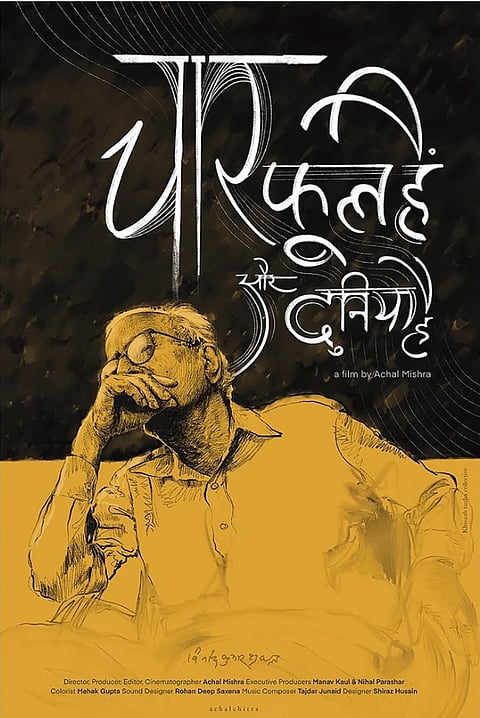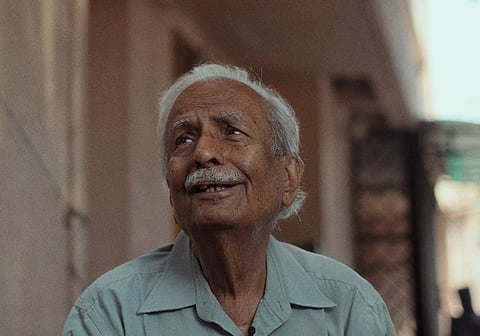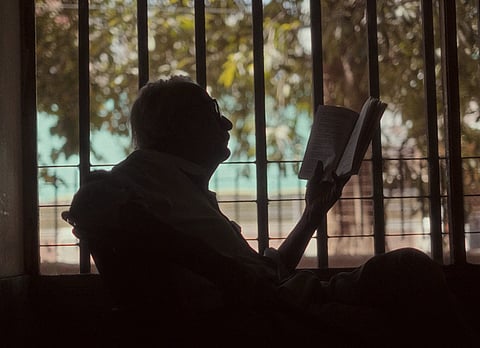In a quiet corner of the house, the literary giant Vinod Kumar Shukla gently oscillates on a wooden swing. He is chatting with actor Manav Kaul on his experiences with legendary parallel cinema director Mani Kaul. Kaul asks him about how he felt when the filmmaker—who adapted Shukla라이브 바카라 1979 novel Naukar Ki Kameez into a film in 1999—passed away. Shukla라이브 바카라 calm voice becomes slightly heavy. He mentions his shock at receiving the news that Kaul was terminally ill. He recalls his last phone conversation with Kaul, where he beseeched him to get better and continue making the film adaptation of his other novel, Deewar Mein Ek Khirkee Rehti Thi (1997). The film never got made—Kaul died before that. He reminisces about their relationship, primarily premised on creativity. Then, in his characteristic style of humour, he says, “Beech beech me behas hoti thi...ki Vinod ji, paani mein rangoli kaise padegi? Phir wo rangoli udegi kaise? Aur wo saree ke roop me kaise lipat jayegi?” (Sometimes, we argued...he would ask me, how can rangoli be put in water? And how will it fly from there? And how will I show it turning into a saree?) A toothy, childlike laughter follows.
Chaar Phool Hain Aur Duniya Hai Review | Unbound Snippets From A Writer라이브 바카라 World
Achal Mishra's latest isn’t meditative because of the aesthetically pleasing chiaroscuro; it is the way the greatness of Vinod Kumar Shukla라이브 바카라 fleeting musings drift through the ordinariness of his lifestyle that draws you into the film.

Achal Mishra라이브 바카라 Chaar Phool Hain Aur Duniya Hai (2024) lulls you quietly into the world of Vinod Kumar Shukla, an eminent Hindi writer and poet from Chhattisgarh. Shukla—who was recently awarded the Jnanpith Award, the highest literary honour in the country—and the space that he inhabits on an everyday basis, are the primary protagonists of this non-fiction work. The style of filmmaking is simple, even unremarkable. Conversations between Kaul, Shukla, and Shukla라이브 바카라 son Shashwat Gopal, are the only dialogues that are heard. Other than that, the language of this film is silence. Different parts of the house and its sentient and non-sentient residents—the trees and plants, the birds and the birdfeeders, the pictures and the books, the walls and the swing—inhabit the frames of the film as the conversations go on. In its depiction, the film attempts to capture the floating, transient moments between the thoughts that must drive the author라이브 바카라 pen.

Many cinephiles and devout Mishra fans are disappointed with the way the film has been made. While some say the film is all about “aesthetics without content”, others are calling it a “missed opportunity” to capture the life and thought of a literary stalwart. However, such a reading eventually falls through, if one were to unburden the form of non-fiction cinema from the onus of the evidentiary. The film isn’t meditative because of the aesthetically pleasing chiaroscuro; it is the way the greatness of Shukla라이브 바카라 fleeting musings drift through the ordinariness of his lifestyle that draws you into the film. An attempt, however flawed, is made by the filmmaker to converse in the language of familiarity that is Shukla라이브 바카라 stronghold. Chaar Phool Hain Aur Duniya Hai isn’t meant to narrate how Shukla has navigated his passion throughout his life; it merely sneaks a glimpse into the simple mundanity of a writer라이브 바카라 process.
The conversations are impromptu; Shukla라이브 바카라 insights are not structured or scripted before being presented on camera. Yet, the depth of his knowledge and calibre seeps through even in these extempore articulations, which come as responses to the most ordinary questions. Meanwhile, the space of his home speaks volumes through its stillness. Not only does it exemplify his thoughts, and the thoughts of his son Gopal, on being grounded in the quotidian for inspiration; it also busts the myth that an author needs groundbreaking, larger-than-life events as a trigger to write profoundly.

Gopal라이브 바카라 insights into his father라이브 바카라 idiosyncrasies as a writer and the investment of the whole family into his creative endeavour need special mention here. The adoration and respect with which he speaks of his ‘Dada’ adds another dimension to the author라이브 바카라 world—that his stories take shape from the enduring love of his family for him and his literary oeuvre.
The breezy innocence in Shukla라이브 바카라 narration style is complemented by the poignant poetry that he recites, which is woven into the conversations within the film. The lightness of frames and the sparse editing allow for the breathing space to take a moment and reflect on what he says and believes. The viewer is absorbed into his words and slips into a reminiscence of instances from their own repository of private memory, giving way to a resonance not just with what is spoken within the meter, but also what is spoken without.
The misgivings that Mishra may have had about making a film on a figure so tall are embedded into his style of capturing Shukla라이브 바카라 daily schedule. Yet, with its humble shortcomings, the film is a loving glimpse—with an undercurrent of a little starry-eyed awe—of an ageing albeit evergreen writer, whose erudition stems from the deep content he feels in his modest world. Summed up succinctly in Shukla라이브 바카라 own words, after he watched the film, “Chaar Phool Hain Aur Duniya Hai Aur Main Bhi Toh Hu.”
